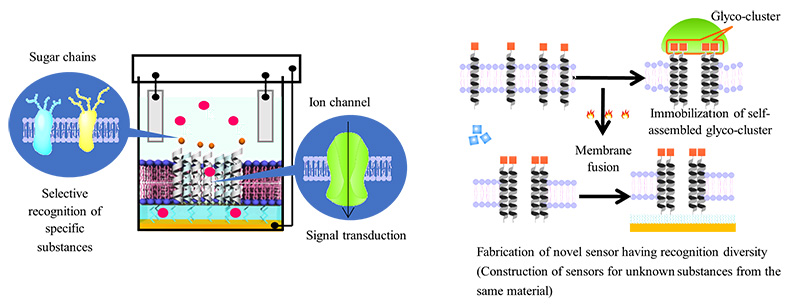Research
Higuch group studies “biomimetic materials” inspired by the structure and function of living organisms. We are less than 2 meters tall and weigh less than 100 kg, but we have various high-performance sensors and locomotor systems, and are equipped with self-healing functions. If we can fabricate the materials that mimic these biological functions, we will be able to realize high-performance devices that can operate with less energy, and these are expected to lead to develop into a sustainable society. Our group uses bio-related macromolecules such as peptides, nucleotides, and sugar chains to constructed self-organized structures. We aim to fabricate biomimetic materials that can express functions based on their structures. Representative studies are shown below.
KEYWORDS: Bio-relative macromolecules : self-organization : purposeful structures : biomimetic materials : functional materials : sensors : organic / inorganic nanocomposites
Biomimetic novel sensors (self-stood sensing systems having recognition diversity)
Cells recognize various substances and transmit that information to the inside. Sugar chains present on the cell surface are used for substance recognition site, and signal transduction is performed by ion permeable pore, ion channel, that penetrate the cell membrane. As shown in the figure, we succeed in fabricate the high-performance sensing systems using sugar chain assembly (glyco-cluster) reconstituted by the target substance as a recognition site, and acting the simultaneously formed peptide bundle as signal transductor. Since the recognition sites are formed by self-organization owing to the molecular interaction among the sugar chains and target substance, it is possible to fabricate the sensor having recognition diversity from the materials with the same composition (mixture of several glyco-peptides).

DDS carriers having environmental recognition and targeting abilities(DDS carriers for cancer chemotherapy)
As drug delivery systems (DDS) for cancer chemotherapy, we are fabricating nanocapsules having environmental recognition and targeting abilities. Our goal for constructing a DDS carrier are those, the capsule has the particle size that can penetrate imperfect new blood vessels neighborhood cancer tissue (EPR effect), it can specifically bind to target cancer cell (targeting ability), and the capsule can collapse under the weakly acidic condition near cancer tissue and release the encapsulated drug (environmental recognition ability). For those purposes, the surface of the vesicle, which is artificial cell, was coated with calcium carbonate, the main component of seashells, using a biomineralization technique. Currently, we are conferring targeting ability by introduce the receptors for cancer cell to the DDS capsule.





